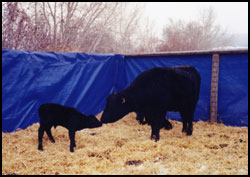Windbreaks
In northern climates, windbreaks can save cattlemen money by reducing feed costs, illness and health costs, and loss of body condition — as well as improving gains on young animals. When cattle are stressed by wind, they seek shelter. Not every ranch has brushy areas or draws the cattle can get into.
"Windbreaks improve efficiency — managing the environment for cattle," says Steve Paisley, Extension beef cattle specialist at the University of Wyoming. "If they are experiencing cold stress, they need to eat more."
A cold, windy day can increase a cow's nutrient requirements by 30%-40%, he explains. During a blizzard in late winter or early spring, windbreaks can prevent problems like pneumonia, frozen ears or frostbitten teats. It's also important to provide protection to bulls to improve their performance and prevent scrotal frostbite.
"At our research station we test bulls, and they're also exposed to wind," says Paisley. "We plan to use hinged metal panels that act as windbreaks when they're rotated down, and during summer they can be rotated up for shade."
Several companies make the tall, solid panels that are hinged in the middle, he says.
Producers try to balance the expense of providing a windbreak with the benefits. There are many ways to create windbreaks.
 "You can buy fabric windbreaks and attach them with zip-ties or lace them to existing panels or fence," says Paisley. "This short-term fix works fairly well. We're putting some of these up in our pens here at the university. Fabric windbreaks are not a long-term structure, but last fairly well. My parents in western Nebraska have some in their calving pens that have been there for 10 years."
"You can buy fabric windbreaks and attach them with zip-ties or lace them to existing panels or fence," says Paisley. "This short-term fix works fairly well. We're putting some of these up in our pens here at the university. Fabric windbreaks are not a long-term structure, but last fairly well. My parents in western Nebraska have some in their calving pens that have been there for 10 years."
Porous windbreaks — such as slats on a fence — work best for maximum space behind them providing wind reduction. A solid structure only gives protection immediately behind it.
"All you need is about 80% wind blockage," says Paisley.
Paisely takes note of different types of windbreaks as he is driving. Low-cost alternatives vary from region to region.
"North of Cheyenne, oil field tires are used as windbreaks. Near Douglas and Gillette you'll see abandoned oil storage tanks on their sides," he says. "There's probably a low-cost solution in your own area, using whatever is readily available and inexpensive. We have beetle-killed timber in our state, which some people are harvesting. This may be a cheaper source of lumber for livestock facilities."











